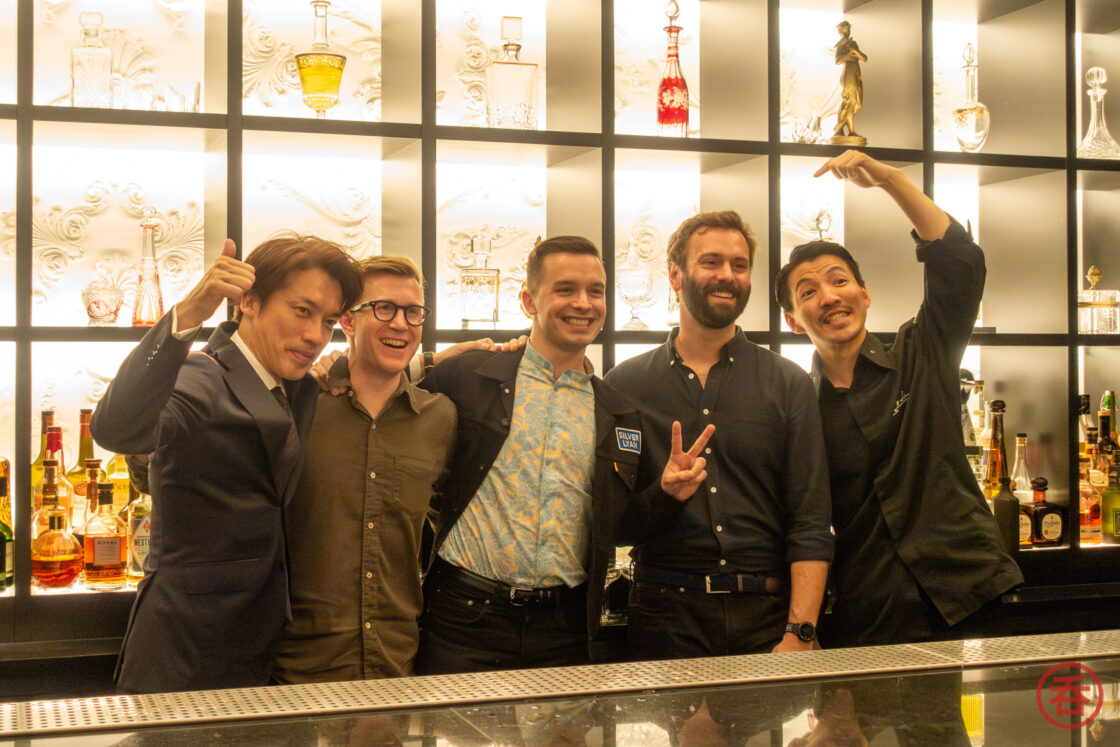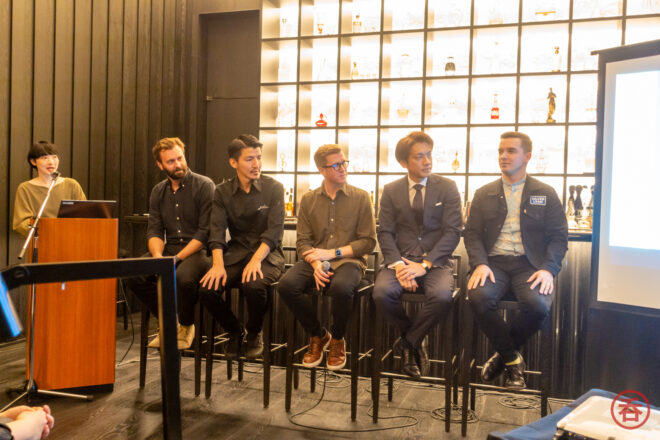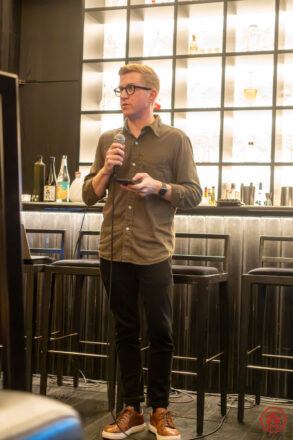In January, Miyazaki Prefecture and JSS recently hosted five bartenders from the US and Japan to experience Miyazaki’s shochu culture. Their trip was nightcapped with an industry event at The Tokyo Edition’s Gold Bar, where they shared their thoughts on Miyazaki shochu and cocktail menu management in general. And, of course, they also made some excellent drinks!
Before getting into the event report, I want to call your attention to the Miyazaki Shochu Pop-Up bar coming to Shibuya’s Kakuuchi Base from March 4th to 10th. From the 4th to the 8th, they’re doing tasting sessions for Miyazaki honkaku shochu, and on March 9th and 10th, they’re bringing in a guest bartender for just an hour each night to make some cocktails described in this article. It should be fun!
Returning to January’s event. It might sound familiar if you’ve been a reader of nomunication for a while. Gold Bar hosted a similar event at the same location in November 2022. Before that, I joined a multi-distillery multi-day press tour to experience Miyazaki shochu culture.
This time, the roster was different (pictured above, left to right):
- Tyson Buhler from Death & Co, New York
- Hideyuki Saito from Gold Bar at Edition, Tokyo
- Alex Day from Death & Co, New York
- Yujiro Kiyozaki from Bar LIBRE, Tokyo
- Vlad Novikov from Silver Lyan, Washington DC
Let’s first go over the cocktail menu insights shared by Death & Co’s Alex Day
Alex Day on Death & Co and menu composition
Death & Co opened on New Year’s Eve in 2006/7, looking to push the boundaries of creativity. The bar has become an institution by what Alex described as “modifying and updating” classic cocktails. Since those beginnings in 2006, the parent company (Gin & Luck) has moved into other markets like Washington DC, Denver, Aspen, Seattle, Las Vegas, Nashville, and Atlanta, and will soon open a whole hotel in Savannah. The goal is to offer what he calls “cocktail-oriented” hospitality.
Apart from running incredibly successful bars, the team has written the book on modern classic cocktails. While the first Death & Co book remains a go-to, Alex says their experience came together with the release of the James Beard Award-winning Cocktail Codex. If you master six cocktails, he says, you can understand the entirety of the cocktail universe. Which six cocktails? Well, read the book.
Alex stressed in his presentation that Death & Co strives to keep creativity at the core of what they do. A key component of that creativity is considering the menu as a composition. Is there enough diversity? Can we actually execute this? Can we actually execute this every day?
The cocktail menu needs to complement and contrast, but more Importantly, the menu needs to tell a story
Alex Day, Death & Co
One of their key creative tools in building such menus is what the company calls “The Wireframe.” The goal is to capture each element of the creative process behind each cocktail in one place, enabling you to see your menu’s story and diversity at a glance. Here’s an example with just one row, but it gives you an idea.
| Style | Brainstorm | Recipe Draft | Prep | Presentation |
| Sour, Collins | Bourbon, Ginger, Apple, Lemon Seltzer | 2 Bourbon, 1 Fuji Apple Juice, 0.75 ginger, 0.5 lemon, seltzer | Ginger syrup, apple juice | Collins, cubes, apple fan |
Another key tool the company uses is Evernote to keep ingredients consistent. Alex showed an example of the company’s recipe for “Infusion: Black Peppercorn Vodka Infusion,” which gives the exact ingredients, tools, and method for preparation. Importantly, this is accessible to anyone who needs it anytime, anywhere.
On Shochu In the Bar
Tyson Buhler is Death & Co’s Food & Beverage Director, and he mentioned that shochu first appeared on the menu at Death & Co in NYC in 2016. Now, it’s on every menu they have. Despite his above presentation, Alex Day said he’s “not allowed” to make drinks anymore, but this trip has inspired him. He also noticed the incredible amount of respect for tradition, yet passion for change, in distillers and flavors of their products.
Gold Bar’s Saito-san mentioned that this trip was his first time in Miyazaki. He was struck by the diversity that the makers showed. He says that if you want inspiration for cocktails, getting ideas from the shochu makers themselves is a great idea. He noted that shochu can sometimes stand in for a smoky scotch or mezcal. “No other spirits” provide the variation that shochu offers.
Kiyozaki-san is from Miyazaki’s neighboring Kumamoto Prefecture, so he grew up drinking shochu. “But not in cocktails,” he says. Given the rising costs of Western spirits like whisky, gin, or tequila, he is particularly interested in the affordability of shochu.
Silver Lyan’s Vlad said he was interested in the US Shochu Cocktail Competition by JSS. Working with shochu in the US without much context was exciting and challenging.
On Miyazaki Prefecture
Tyson Buhler says that while he has traveled to many countries, the ones he finds the most interesting are those where the people have the utmost respect for the land and the place. Which Miyazaki’s distillers certainly do. This means a focus on using local ingredients.
Vlad was struck by the distillers themselves and the community that they have. He noted their “earnest joy” when tasting each other’s distillates. He also noted how every distiller had something they were passionate about: soil/farming, the mountainous location, and steam injection.
The drinks
Moving into the cocktail session, I’ll let the photos do most of the talking (or writing). My personal favorite was probably the Ajax Old Fashioned. It’s great to see shochu and shochu cocktails getting more traction inside and outside Japan.
Hi there! I created and run nomunication.jp. I’ve lived in Tokyo since 2008, and I am a certified Shochu Kikisake-shi/Shochu Sommelier (焼酎唎酒師), Cocktail Professor (カクテル検定1級), and I hold Whisky Kentei Levels 3 and JW (ウイスキー検定3級・JW級). I also sit on the Executive Committees for the Tokyo Whisky & Spirits Competition and Japanese Whisky Day. Click here for more details about me and this site. Kampai!















